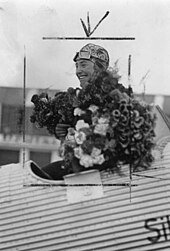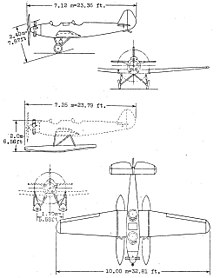Junkers A 50
| Junkers A 50 | |
|---|---|
 Junkers A 50 in the Deutsches Museum |
|
| Type: | Sport plane |
| Design country: | |
| Manufacturer: | |
| First flight: |
February 13, 1929 |
| Number of pieces: |
69 |
The Junkers A 50 was a single-engine, two-seat, all-metal light aircraft whose maiden flight took place on February 13, 1929. The construction built by Junkers & Co. was designed by Hermann Pohlmann (1894–1991) and used the light metal corrugated sheet planking typical of Junkers aircraft. The machine was sometimes referred to as the A 50 "Junior".
Type history
After the first flight in February 1929, a total of five prototypes were built in the course of the year to test various engines. Junkers hoped for a production number of 5,000 copies of the A 50, which was intended as a kind of people's aircraft, but only 69 could be produced during the construction period, as the aircraft was quite expensive at around 16,000 Reichsmarks; In addition, there was a global economic crisis from October 1929 . Only 50 of the machines built were sold. These planes went to Finland , Switzerland , Japan , Portugal , South Africa , Great Britain , Brazil and Australia , among others . Some machines were also used by airlines . Several A 50s took part in the European sightseeing flights of 1929 and 1930 .
If there was no passenger on board, the unoccupied space could be closed with a cover. From the A 50ce onwards, the wings could be folded onto the fuselage for a road overpass.
tries
A number of experimental conversions were tried out with the A 50. A unicycle undercarriage was tested that had a wheel centrally under the fuselage. There were resilient runners under the wings.
One machine was converted to a high-decker . Experiments with a variable angle of incidence of the wing were made on this machine .
Records

The A 50 type set a number of FAI world records. In the design with floats and the 59 kW Armstrong-Siddeley-Genet engine:
- June 4, 1930: altitude of 5652 m without passengers
- June 4, 1930: altitude of 4614 m with one passenger
- June 6, 1930: 900.180 km range (for the closed course with one passenger)
- June 6, 1930: 8:27 h flight time (for the closed course with one passenger)
- June 6, 1930: Average speed 164.30 km / h (on a closed course with one passenger)
- June 13, 1930: 2100.420 km range (for the closed course without passengers )
- June 13, 1930: 16:29 h flight time (for the closed course without passengers)
- June 13, 1930: Average speed of 165.44 km / h (on closed course without passengers)
In 1930, Marga von Etzdorf was the first woman to fly alone from Berlin to Tokyo with her yellow Junkers Junior.
variants
- A 50
Basic model with a 59 kW Armstrong-Siddeley-Genet engine. The wings are still without a V-position.
- A 50ba
V-shaped wings, 59 kW Walter engine
- A 50be
V-shaped wings, but Armstrong Siddeley Genet with 59 kW
- A 50ce
Wings with V-position; with 63 kW Armstrong Siddeley Genet II engine, also equipped with the Genet Major I with 74 kW for export . Foldable wings
- A 50ci
V-shaped wings with a 65 kW Siemens & Halske Sh 13 engine. Foldable wings
- A 50fe
V-shaped wings, 63 kW Armstrong-Siddeley-Genet II engine, additional modifications to the airframe , folding wings
Received aircraft

One copy is in the Deutsches Museum in Munich, one is in the departure hall of Helsinki-Vantaa Airport .
A third aircraft was exported to Australia in the 1930s and flew there with interruptions until the 1990s. At the beginning of 2009 this A 50 was brought to Germany to the “Hugo Junkers” technology museum in Dessau , where it is waiting for restoration on loan from a private collector.
Technical specifications
| Parameter | Data |
|---|---|
| crew | 2 |
| length | 7.12 m |
| span | 10.00 m |
| height | 2.40 m |
| Wing area | 13.70 m² |
| Wing extension | 7.3 |
| Wing loading | 43.80 kg / m² |
| Empty mass | 360 kg |
| Payload | 240 kg |
| Takeoff mass | 600 kg |
| Top speed | 172 km / h |
| Cruising speed | 145 km / h |
| Climb performance | 2.80 m / s |
| Service ceiling | 4600 m |
| Range | 600 km |
See also
Web links
Individual evidence
- ↑ Bruno Lange: Type manual of German aviation technology. A reference work on German powered aircraft, airships, aircraft engines, turbo and rocket engines, missiles, propellers, on-board instruments, radio systems and on-board weapons from the beginning until today (= Deutsche Luftfahrt. Vol. 9). Bernard & Graefe, Koblenz 1986, ISBN 3-7637-5284-6 , p. 185.
- ↑ a b Deutsches Museum: Junkers A 50 "Junior", accessed on May 15, 2010
- ↑ Junkers flies above gate 28. In: helsinki-vantaa.fi . Archived from the original on May 9, 2012 ; retrieved on June 29, 2020 (English, formerly D-1915 ): "Registration number: OH-ABB - The first two letters of the suffix, AB are the initials of Bremer's wife, Astrid Bremer, and the second B signifies that the plane was Bremer's second. "
- ↑ Junkers.de: ( Memento from August 30, 2009 in the Internet Archive ) Junkers A 50 WNr. 3517
- ↑ Peter W. Cohausz: Junkers A 50 Junior - a legend returns . In: Flugzeug Classic . No. 4 , 2009, ISSN 1617-0725 , p. 32-36 .
- ^ Günter Schmitt: Junkers and his planes . Transpress, Berlin 1986, ISBN 3-344-00192-2 , p. 182/183 .





